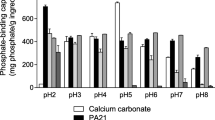Summary
To assess directly the effect of ionic dissociation on the bioavailability of calcium, we used the double isotope inverse convolution method to compare the absorption of calcium gluconate and calcium pyrrolidone carboxylate, an organic, highly dissociated salt. Two tests were performed at a 2 day interval, using in random sequence either salt as a carrier. Forty-eight subjects of various age and clinical condition were studied. The use of the more dissociated salt consistently and significantly increased fractional absorption in a rather constant ratio. Moreover, it slowed absorption in normal subjects whatever their age, and accelerated it in patients with chronic renal failure or osteoporosis, leading to inferences on the alteration of calcium absorption in these conditions.
Similar content being viewed by others
References
Favus MJ (1984) Intestinal calcium transport. In: Coe FL (ed) Hypercalciuric states. Grune & Stratton, Orlando, pp 37–63
Birge SJ, Peck WA, Berman M, Whedon GD (1969) Study of calcium absorption in man: a kinetic analysis and physiologic model. J Clin Invest 48:1705–1713
Jovanovic V (1978) Determination of intestinal radiocalcium absorption by a double tracer method with 85 Sr i.v. Eur J Nucl Med 3:115–120
Wooton R, Reeve J (1980) The relative merits of various techniques for measuring calcium absorption. Clin Sci 58: 287–293
Phan-Din-Tuy B, Moczar E (1978) Effect of calcium pyrrolidone carboxylate on macromolecule formation in bone matrix. Ann Biol Anim Biochim Biophys 18:133–136
Weast RC (ed) (1985) CRC handbook of chemistry and physics. CRC Press, Boca Raton, pp B81-B84
Riggs BL, Melton LJ (1983) Evidence for two distinct syndromes of involutional osteoporosis. Am J Med 75:899–901
Pacifici R, Droke D, Avioli LV (1985) Intestinal lactase activity and calcium absorption in the aging female with osteoporosis. Calcif Tissue Int 37:101–102
Hunt JN, Johnson C (1983) Relation between gastric secretion of acid and urinary excretion of calcium after oral supplements of calcium. Dig Dis Sci 28:417–421
Francis RM, Peacock M, Taylor GA, Storer JH, Nordin BEC (1984) Calcium malabsorption in elderly women with vertebral fractures: evidence for resistance to the action of vitamin D metabolites on the bowel. Clin Sci 66:103–107
Gallagher JC, Riggs BL, Eisman J, Hamstra A, Arnaud SB, De Luca H (1979) Intestinal calcium absorption and serum vitamin D metabolites in normal subjects and osteoporotic patients. J Clin Invest 64:729–736
Author information
Authors and Affiliations
Rights and permissions
About this article
Cite this article
Marchandise, X., Pagniez, D., Ythier, H. et al. Influence of accompanying anion on intestinal radiocalcium absorption. Calcif Tissue Int 40, 8–11 (1987). https://doi.org/10.1007/BF02555721
Received:
Revised:
Issue Date:
DOI: https://doi.org/10.1007/BF02555721




